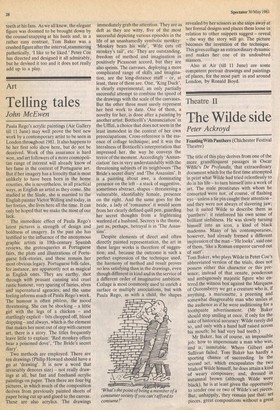Art
Telling tales
John McEwen
Paula Rego's acrylic paintings (Air Gallery till 11 June) may well prove the best new work by a contemporary artist to be seen in London throughout 1981. It also happens to be her first solo show here, but do not be deceived. Work of this assurance is hard won, and art followers of a more cosmopolitan range of interest will already know of her fame in the context of Portuguese art. But if her imagery has a ferocity that is most unlikely to have been born in the home counties, she is nevertheless, in all practical ways, as English an artist as they come. She studied at the Slade, she is married to the English painter Victor Willing and today, in her forties, she lives here all the time. It can only be hoped that we make the most of our luck.
The immediate effect of Paula Rego's latest pictures is strength of design and boldness of imagery. In the past she has testified to the influence of the anonymous graphic artists in 19th-century Spanish reviews, the grotesqueries at Portuguese fairs, the plots and illustrations of Portuguese folk-stories, and these remain her most obvious legacy. Portuguese folk-tales, for instance, are apparently not as magical as English ones. They are earthy, shot through with peasant cunning and cruel rustic humour, very sparing of fairies, elves and supernatural agencies; and the same feeling informs much of Paula Rego's work. The humour is often pitiless, the mood threatening. She can be shocking — a little girl with the legs of a chicken — and startlingly explicit bits chopped off, blood dripping—and always, which is the element that makes her most out of step with current art, there is a story. The titles frequently leave little to explain: 'Red monkey offers bear a poisoned dove', 'The Bride's secret diary'.
Two methods are employed. There are ten drawings (Philip Howard should have a go at 'drawing'. It is now a word that invariably denotes size) — not really drawings at all, but fast and freehand acrylic paintings on paper. Then there are four big pictures, in which much of the composition derives from previously painted sheets of paper being cut up and glued to the canvas. These are also acrylics. The drawings immediately grab the attention. They are as deft as they are witty, five of the most successful depicting various episodes in the life of an unashamedly symbolic monkey: 'Monkey beats his wife', 'Wife cuts off monkey's tail', etc., They are outstanding, freedom of method and imagination in positively Picassoan accord, but they are also sprints. The canvases, deploying a more complicated range of skills and imagination, are the long-distance stuff — or, at least, three of them are. One, 'King Duck', is clearly experimental; an only partially successful attempt to combine the speed of the drawings with the scale of the canvases. But the other three must surely represent her best work to date. One of them, a novelty for her, is done after a painting by another artist: Botticelli's `Annunciation' in the Uffizi, a choice that does not seem in the least immodest in the context of her own preoccupations. Cross-reference is the essence of collage technique; and it was the literalness of Botticelli's interpretation that impressed her, the way he conveys the terror of the moment. Accordingly 'Annunciation' ties in very understandably with the threatening subjects of its neighbours 'The Bride's secret diary' and 'The Assassins'. It is a painting about awe, a dominating presence on the left — a stack of suggestive, sometimes abstract, shapes — threatening a vulnerable, identifiably female, presence on the right. And the same goes for the bride, a lady of `rornaunce it would seem from her clearly defined quill pen, guarding her secret thoughts from a frightening warlord of a husband. Secrecy is the theme, just as, perhaps, betrayal is in 'The Assassins'.
Despite elements of direct and often directly painted representation, the art in these larger works is therefore of suggestion; and, because the outcome is such a perfect expression of the technique used, the harmony of method and result proves no less satisfying than in the drawings, even though different in kind and in the service of a different order of imaginative ambition. Collage is most commonly used to enrich a surface or multiply associations, but with Paula Rego, as with a child, the shapes revealed by her scissors as she snips away at her formal designs and places them loose in relation to other snippets suggest — reveal — the way the story will go. The picture becomes the invention of the technique. This gives collage an extraordinary dynamic and makes her one of its undoubted masters.
Also at Air (till 11 June) are some competent portrait drawings and paintings of places, for the most part in and around London, by Ronald Boyd.










































 Previous page
Previous page